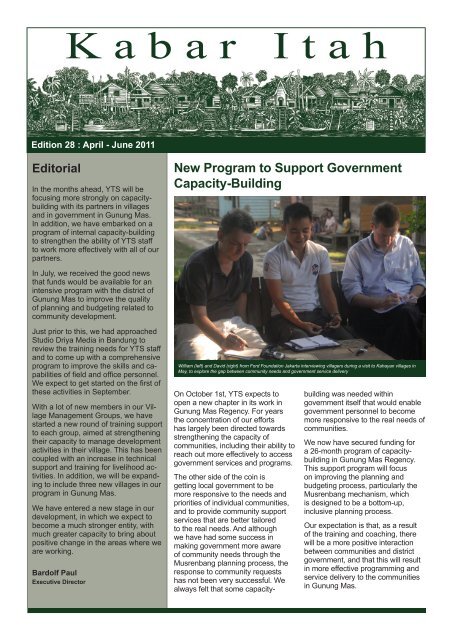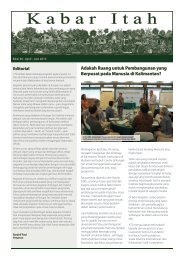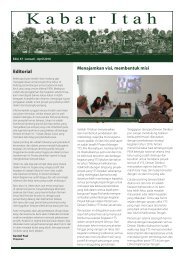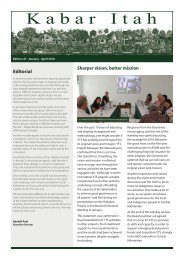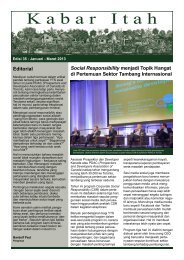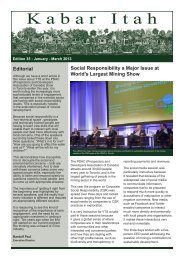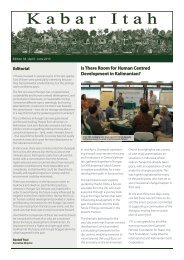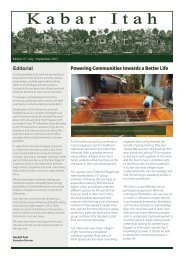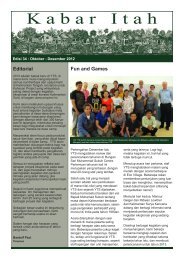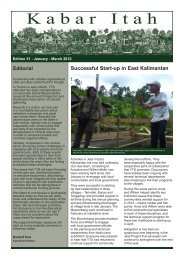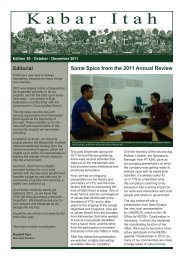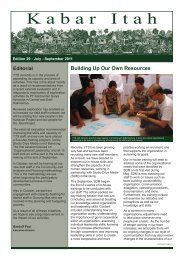Kabar Itah 2011-28 (E)
Kabar Itah 2011-28 (E)
Kabar Itah 2011-28 (E)
You also want an ePaper? Increase the reach of your titles
YUMPU automatically turns print PDFs into web optimized ePapers that Google loves.
K a b a r I t a h<br />
Edition <strong>28</strong> : April - June <strong>2011</strong><br />
Editorial<br />
In the months ahead, YTS will be<br />
focusing more strongly on capacitybuilding<br />
with its partners in villages<br />
and in government in Gunung Mas.<br />
In addition, we have embarked on a<br />
program of internal capacity-building<br />
to strengthen the ability of YTS staff<br />
to work more effectively with all of our<br />
partners.<br />
New Program to Support Government<br />
Capacity-Building<br />
In July, we received the good news<br />
that funds would be available for an<br />
intensive program with the district of<br />
Gunung Mas to improve the quality<br />
of planning and budgeting related to<br />
community development.<br />
Just prior to this, we had approached<br />
Studio Driya Media in Bandung to<br />
review the training needs for YTS staff<br />
and to come up with a comprehensive<br />
program to improve the skills and capabilities<br />
of field and office personnel.<br />
We expect to get started on the first of<br />
these activities in September.<br />
With a lot of new members in our Village<br />
Management Groups, we have<br />
started a new round of training support<br />
to each group, aimed at strengthening<br />
their capacity to manage development<br />
activities in their village. This has been<br />
coupled with an increase in technical<br />
support and training for livelihood activities.<br />
In addition, we will be expanding<br />
to include three new villages in our<br />
program in Gunung Mas.<br />
We have entered a new stage in our<br />
development, in which we expect to<br />
become a much stronger entity, with<br />
much greater capacity to bring about<br />
positive change in the areas where we<br />
are working.<br />
Bardolf Paul<br />
Executive Director<br />
William (left) and David (right) from Ford Foundation Jakarta interviewing villagers during a visit to Kahayan villages in<br />
May, to explore the gap between community needs and government service delivery<br />
On October 1st, YTS expects to<br />
open a new chapter in its work in<br />
Gunung Mas Regency. For years<br />
the concentration of our efforts<br />
has largely been directed towards<br />
strengthening the capacity of<br />
communities, including their ability to<br />
reach out more effectively to access<br />
government services and programs.<br />
The other side of the coin is<br />
getting local government to be<br />
more responsive to the needs and<br />
priorities of individual communities,<br />
and to provide community support<br />
services that are better tailored<br />
to the real needs. And although<br />
we have had some success in<br />
making government more aware<br />
of community needs through the<br />
Musrenbang planning process, the<br />
response to community requests<br />
has not been very successful. We<br />
always felt that some capacitybuilding<br />
was needed within<br />
government itself that would enable<br />
government personnel to become<br />
more responsive to the real needs of<br />
communities.<br />
We now have secured funding for<br />
a 26-month program of capacitybuilding<br />
in Gunung Mas Regency.<br />
This support program will focus<br />
on improving the planning and<br />
budgeting process, particularly the<br />
Musrenbang mechanism, which<br />
is designed to be a bottom-up,<br />
inclusive planning process.<br />
Our expectation is that, as a result<br />
of the training and coaching, there<br />
will be a more positive interaction<br />
between communities and district<br />
government, and that this will result<br />
in more effective programming and<br />
service delivery to the communities<br />
in Gunung Mas.
Seeking Best Practice in the Mining Sector<br />
Resource companies with long-term goals<br />
can be at the vanguard of good community<br />
development if they take a long-term<br />
view of development. Corporate Social<br />
Responsibility is increasingly becoming<br />
more than just a catch-phrase in Indonesia,<br />
and more demands are being put on<br />
resource companies to show real social<br />
benefits. Thus, many forward-looking<br />
miners are searching for better ways to<br />
approach the social challenges they face.<br />
As a result, there has been increased<br />
interest in our participatory approach,<br />
and several mining companies have<br />
recently approached us for assistance<br />
with their CSR needs. As we have proved<br />
our methodology is widely replicable,<br />
we find we are now in a good position<br />
to provide other companies with a<br />
supporting framework for their community<br />
development programs.<br />
Recently, we have hosted several field<br />
visits from two major mining companies:<br />
Tigers Realm and Robust Resources. We have been<br />
pleased to have been able to provide their community<br />
development teams with advice and mentoring support, and<br />
the opportunity to do field based learning.<br />
We also welcome the recent interest of Good Hope, a large<br />
company working in Central Kalimantan in the oil-palm<br />
plantations sector. Following two visits from their staff, YTS<br />
YTS management assistant, Goen (far right), assists Good Hope team in a field visit to Tewei Hara Village<br />
has now also performed an initial survey of two villages in<br />
their concession area, with a view to establishing a pilot<br />
project in one village and providing training to their staff in<br />
the application of our methodology.<br />
As an independent foundation, we feel we have now<br />
reached the point where we have something to offer that<br />
can be of benefit not only to resource companies, but also to<br />
government and local people.<br />
Stronger Networks, Better Services<br />
In May, YTS was invited for a meeting with several<br />
development organizations that are all currently working<br />
in Bukit Batu. The meeting was initiated by BOSF, the<br />
Borneo Orangutan Survival Foundation, and was intended<br />
to help synchronize the development activities of the<br />
various organizations.<br />
Being a poor rural area that is relatively close to the city,<br />
Bukit Batu has become a field site for several community<br />
development and conservation organizations. These<br />
organizations provide similar activities, but have different<br />
specific objectives and methodologies. Nonetheless,<br />
many of the programs require the same sets of data,<br />
as well as community participation and the formation of<br />
community groups. This can cause a situation where<br />
parallel processes are conducted in a community by<br />
different organizations. For example, when collecting<br />
data or using PRA tools, it is important for<br />
these organizations to avoid repeating the<br />
same activities over and over again, as the<br />
community can quickly tire of this attention.<br />
Thus, the idea of this meeting was to get<br />
these organizations to share their thoughts<br />
and look into possibilities for future collaboration.<br />
This initiative intends to synchronize<br />
the various respective activities of each organization<br />
in order to provide more tangible<br />
results from similar programs.<br />
Kanarakan village; many organizations with similar programs have been working in the area to improve the villagers’<br />
livelihood. The village still has no access to electricity, despite its relative close distance to the capital city.<br />
The first meeting was held successfully,<br />
and was attended by BOSF, WWF, YUM,<br />
PNPM, YTS, and other community organizations.<br />
A follow-up meeting will be<br />
scheduled in the next quarter to discuss<br />
an agenda and possible action plan for the<br />
future.<br />
2<br />
<strong>Kabar</strong> <strong>Itah</strong> - Edition <strong>28</strong>
Broader and Deeper: External Evaluation Indicates the Way Ahead<br />
SDIA, Susila Dharma International Association, provided<br />
funding in early <strong>2011</strong> to commission an external evaluation<br />
of YTS’s work in villages in the Kahayan River watershed.<br />
The main objective of the evaluation was to help YTS<br />
prepare for a major expansion of the Kahayan Project, and<br />
to help it access the major funding needed to support this<br />
expansion.<br />
The funds were provided to SDIA by the<br />
Blond Trust, as part of a broad initiative<br />
to support capacity-building within the<br />
SDIA network. YTS is a member of<br />
this network and is using the results<br />
of the evaluation to create a capacitybuilding<br />
program for strengthening<br />
the skills and capabilities of field and<br />
office staff working on projects. The<br />
capacity-building program is aimed at<br />
improving the following competencies:<br />
training; management, leadership, and<br />
team-building; and visualisation, media<br />
development, and facilitation.<br />
In addition to this, management<br />
and staff at YTS have created a<br />
set of 10 action steps based on<br />
recommendations from the evaluation.<br />
The evaluation confirmed that the<br />
basic approach and methodology of<br />
YTS was sound, but that it needed to<br />
be strengthened and intensified by<br />
devoting more time and resources to the program in the<br />
villages, and also to intensify the relationship with local<br />
government in the district and subdistrict.<br />
Both the capacity-building program and the 10-action-steps<br />
program are already underway. We will report on how these<br />
programs are doing in future issues.<br />
A villager from Tumbang Mahuroi provides explanations to Ibu Entin for the external evaluation<br />
Capacity Building: Growing from Within<br />
A large part of our effort has always been to focus on<br />
building local capacity in the communities where we are<br />
working. Various technical trainings have been provided<br />
to assist the community to actively take a role in their own<br />
development. We are making efforts to improve the way<br />
that we deliver our field programs, and we are responding<br />
to the findings of the recent external evaluation of our<br />
work, by taking specific actions to improve those aspects<br />
which were highlighted in the report.<br />
Tj (middle) visits Marang village to gain feedback on the needs for capacity building within the villages<br />
Along with this effort, and in line with the recommendations<br />
from the external evaluation, we strongly believe that<br />
internal capacity building is also required within our<br />
organization, to equip our staff with more skills than before,<br />
especially as we plan to expand our activities to cover a<br />
broader area in future.<br />
As a result, in the past few months, the Yayasan has<br />
been building a closer working relationship with a media<br />
group based in Bandung that is highly<br />
experienced in social development issues<br />
across Indonesia. Studio Driya Media have<br />
now agreed to help us to build our in-house<br />
capacity; starting in the coming months.<br />
Thus, we have already had an initial visit from<br />
TJ, a director of SDM who spent three days<br />
working with us in May. TJ made a field visit<br />
to meet directly with communities in Bukit<br />
Batu that we work with, and spent two days<br />
in intensive meetings with all of our YTS staff<br />
to get a better sense of our capacity building<br />
needs.<br />
This initial visit will be followed up with a<br />
series of action plans and programs to build<br />
YTS staff capacities. By building our internal<br />
capacities, we hope to be able to provide<br />
better services and more assistance to the<br />
communities we are currently working with,<br />
as well as in our expanding project area.<br />
3<br />
<strong>Kabar</strong> <strong>Itah</strong> - Edition <strong>28</strong>
Village Profile: Marang<br />
Around 20 kilometers from the provincial<br />
capital of Palangka Raya, lies the forested<br />
village of Marang, one of seven communities<br />
in the administrative area of Bukit Batu<br />
Subdistrict. Established in 1909, the village<br />
was founded by five households. The<br />
community has been growing steadily since,<br />
and Marang was finally established as an<br />
administrative village in 1983.<br />
There is still a lack of basic infrastructure in<br />
the village. Families send their children to<br />
study in Palangka Raya or in other villages,<br />
as education facilities are lacking in Marang.<br />
The same is true of health facilities: as the<br />
location is quite close to the capital, most<br />
villagers choose to use the health facilities in<br />
the city. The worst health issue was in 1934,<br />
when many villagers died from chicken-pox,<br />
diarrhea and high fever.<br />
Fishing has been the main source of livelihood and recreation for the villagers and people from outside Marang<br />
Despite the lack of facilities, Marang is a beautiful<br />
village, with many small blackwater lakes spread all<br />
over the area. Most households make their living<br />
by fishing and the lakes are still pristine, containing<br />
many different kinds of freshwater fish. The lakes<br />
also attract many people from outside the village,<br />
who often visit the village to fish during the dry<br />
season. When the dry season is over, some of the<br />
villagers switch over to other livelihoods such as<br />
farming, collecting rattan and raising livestock.<br />
The Mayor of Palangka Raya Municipality (left) visited during the first fish harvest in Marang<br />
Since 2009, YTS has been working in this village to<br />
help the villagers improve their economic livelihood<br />
capacity. We have provided training in aquaculture<br />
and poultry-raising. Although the village has easy<br />
access to the government, the villagers still need<br />
more assistance to fully participate in their own<br />
development and to better manage their livelihoods<br />
in order to have a sustainable income in the future.<br />
News Flash<br />
Agenda<br />
Agricultural Training Set to Start in Romang<br />
In August, YTS will return to Romang together with two agricultural trainers, to<br />
meet with the farmer’s interest groups, and to sign a training contract in each of<br />
the six villages on the island. This initial visit will also provide the trainers with an<br />
opportunity to get a first-hand view of the rice and corn fields, and discuss the<br />
difficult soil and rainfall conditions on the island.<br />
Kahayan Program<br />
To kickstart the expansion of our work in Kahayan, a series of Community-Led<br />
Analysis and Planning (CLAP) exercises will be held in new villages in the next<br />
quarter. In June, the team conducted visits to several villages to identify which<br />
villages to work with, and to find out how to prepare for the intensive four-day activities.<br />
UNEP Projects Reduce Mercury in Artisanal & Small Scale Goldmining<br />
In June, YTS performed an independent evaluation of the UNEP SAICM-QSP<br />
Artisanal and Small Scale Gold Mining Regional Project in Asia which was a oneyear<br />
project that focused on making Strategic National Plans to deal with Mercury<br />
in ASGM in Cambodia and the Philippines. In July, YTS was informed that it will<br />
receive a significant new funding component for the Blacksmith Project from the<br />
US Environmental Protection Authority and UNEP. This will allow us to undertake<br />
a one-year project focused on reducing and eliminating Mercury use in ASGM.<br />
July<br />
Bukit Batu: Micro enterprise training I<br />
Kahayan: Vegetable training I<br />
Blacksmith: Visit to new sites in Mt. Muro<br />
Training socialization in Romang, Maluku<br />
August<br />
Bukit Batu: Follow up on Micro enterprise<br />
training<br />
Kahayan:Vegetable Training II, Fish<br />
Training II<br />
Agriculture Expert’s visit to Romang<br />
September<br />
Bukit Batu:Micro Enterprise training II<br />
Kahayan:Vegetable Training III, Initial visit<br />
by Rubber Expert, CLAP in Damang Batu<br />
& Miri Manasa<br />
Capacity Building training with SDM<br />
<strong>Kabar</strong> <strong>Itah</strong><br />
<strong>Kabar</strong> <strong>Itah</strong> is the quarterly newsletter of Yayasan Tambuhak Sinta<br />
(YTS), an affiliate of PT. Kalimantan Surya Kencana (KSK),<br />
a mineral exploration company.<br />
Published by:<br />
Yayasan Tambuhak Sinta<br />
Jl. Badak VII No. 2 Bukit Tunggal<br />
Palangka Raya 73112<br />
Kalimantan Tengah-Indonesia<br />
Telp. +62 (0536) 3237184<br />
Fax. +62 (0536) 3229187<br />
Email:tambuhaksinta@gmail.com<br />
Website: www.tambuhaksinta.com<br />
Bank Accounts:<br />
Yayasan Tambuhak Sinta<br />
BNI 1946<br />
Palangka Raya Branch<br />
Central Kalimantan<br />
INDONESIA<br />
Number 0114981608<br />
Swift: BNINIDJA<br />
4<br />
<strong>Kabar</strong> <strong>Itah</strong> - Edition <strong>28</strong>


